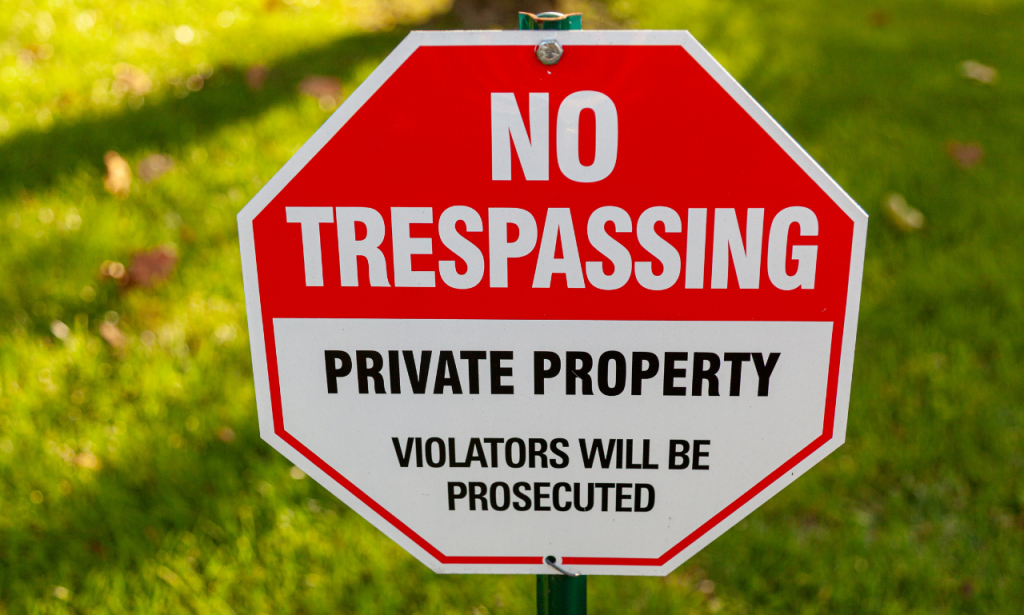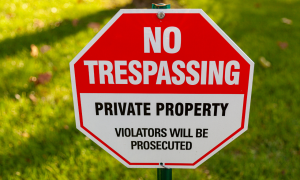Trespassing happens more often than you might think. I’ve seen countless cases where people crossed property lines without realizing the consequences. Fines for trespassing vary widely from $50 to $5,000, depending on several factors. Some cases even result in jail time. Understanding trespassing laws can save you from unexpected legal troubles. This article breaks down everything you need to know about trespassing fines. You’ll learn about different types of trespassing and their penalties. We’ll also cover valid legal defenses if you’re facing charges.
Is Trespassing a Serious Crime?

Trespassing may seem minor compared to other offenses. However, the legal system takes it quite seriously. Most jurisdictions classify trespassing as a misdemeanor, which means it can result in fines and potential jail time. The severity depends on several important factors. Where you trespass matters significantly. Entering certain properties carries stricter penalties.
I once consulted for a client who faced serious charges. He thought cutting through private property was harmless. The property had clear “No Trespassing” signs posted. The landowner pressed charges aggressively. What seemed like a shortcut resulted in a $1,000 fine. The case taught me how seriously courts take property rights.
Repeat offenses also increase the severity of trespassing charges. First-time offenders often receive lighter penalties. Multiple violations show a pattern of disregard for property rights. Some states have enacted enhanced penalties for specific locations. Schools, agricultural lands, and critical infrastructure have special protections.
What Are the Different Types of Criminal Trespassing?
Trespassing isn’t a one-size-fits-all offense. The law recognizes several distinct categories, each with different elements and potential penalties.
First-Degree Trespassing
The most severe trespassing offense belongs to first-degree trespassing. Entering buildings or secure structures without permission constitutes the main element of first-degree trespassing. A person must enter the property both knowingly and voluntarily. Entry must be prohibited by clear signs. Physical barriers and posted signs serve as legal notice against entry. Breaking into properties, including homes and businesses, belongs to this category of offenses.
The punishments for first-degree trespassing offenses become extremely severe. Fines commonly range from $500 to $5,000. The law in certain jurisdictions allows for a maximum of one year imprisonment. Trespassers’ possession of weapons will lead to more severe criminal penalties.
Second-Degree Trespassing
The law considers properties with diminished security levels to be second-degree trespassing. Entering areas enclosed by fences or lands is a violation of this category. Warning signs should be displayed, but their visibility might be reduced. The category encompasses yards, private fields, and comparable areas. The trespasser must still knowingly enter without permission.
The penalties for second-degree trespassing are moderate. Fines typically range from $250 to $1,000. Jail time is possible but less common than with first-degree. Sentences rarely exceed 90 days of incarceration.
Defiant Trespassing
Defiant trespassing occurs after an explicit warning. The person enters or remains despite direct notification. This might happen after a verbal warning from the owner. It also applies when someone refuses to leave when requested. Returning after being banned constitutes defiant trespassing.
Penalties reflect the deliberate nature of the violation. Fines typically range from $300 to $2,500, and jail sentences of up to six months are possible. Courts view defiance as an aggravating factor.
Agricultural Trespassing

Agricultural trespassing specifically protects farmland and ranches. Many states have enacted special protections for these properties. Entering agrarian land without permission constitutes this offense. It includes croplands, orchards, and livestock areas.
Penalties often exceed those of standard trespassing. Fines can range from $500 to $3,000. Some cases include restitution for any crop damage. Jail sentences typically max out at six months.
Felony Trespassing
Certain circumstances elevate trespassing to felony status, typically involving additional criminal elements. Carrying weapons while trespassing triggers felony charges. Trespassing with intent to commit another crime qualifies. Causing significant property damage during trespassing is another factor.
Felony trespassing carries severe consequences. Fines commonly exceed $5,000 in many jurisdictions, and prison sentences range from one to five years. Permanent criminal records significantly impact future opportunities.
What Are the Penalties for a Criminal Trespassing Conviction?
Different areas enforce different levels of punishment for trespassing offenses. Knowledge of possible consequences allows defendants to make suitable preparations for their defense.
Fines
Trespassing fines are the most typical punishment for those convicted of trespassing offenses. The cost of simple trespassing offenses falls between $50 and $500. The sentence for more significant trespassing offenses exceeds $1,000 and can reach $5,000. The punishment for felony trespassing includes penalties that exceed $10,000 in fines. Courts determine penalties based on defendants’ financial standing. The cost of property restitution increases the total financial responsibility.
Jail Time
Incarceration remains possible for most trespassing convictions. Simple trespassing rarely results in jail time. More serious categories can bring sentences of 30-90 days. Felony trespassing may result in 1-5 years imprisonment. The judicial system gives first-time trespassers the option of receiving suspended sentences. Each judge evaluates the individual conditions that surround each case.
Probation
Trespassing offenders often receive probation as part of their sentencing from courts. The duration of probationary periods spans between half a year and two full years. The required conditions usually involve periodic meetings with supervising officers. Legal requirements demand that individuals must keep away from the property that has been trespassed. Breaking probation rules will result in the reactivation of the previously suspended jail term.
Restitution
When trespassing results in property damage, restitution applies. Courts order payment for repair or replacement costs in addition to standard fines. Property owners must document all damage claims.
Criminal Record
Perhaps the most lasting penalty is a criminal record. Misdemeanor trespassing remains on records for several years, and felony convictions may permanently appear on background checks. This significantly affects employment opportunities. Housing applications often screen for property crime convictions.
What Are the Elements of Criminal Trespassing?
Prosecutors must prove specific elements to secure a conviction. Understanding these components helps build effective defenses.
The foundation of any trespassing case is unauthorized entry. Prosecutors must prove the defendant lacked permission. Entry can be a physical presence on the property. The prosecution must show clear boundary crossing. The entry must be intentional rather than accidental.
Notice
Notice is an essential factor in determining most trespassing cases. The defendant needs to understand that entry is forbidden. The most frequently used method to alert individuals is posted signs. Notice through physical barriers such as fences also serves to inform trespassers clearly. The prosecution needs to demonstrate that the notice was easily noticeable.
Intent
Criminal intent distinguishes trespassing from accidental entry. The prosecution must prove knowledge and willfulness. The defendant must have deliberately chosen to enter. Mistakes or emergency circumstances may negate this element. Intent doesn’t require a malicious purpose.
Lawful Control by Others
Prosecutors must establish the property owner’s legal rights. The complainant must have lawful control of the property. Ownership, lease agreements, or management authority qualify. Disputed property ownership can complicate trespassing cases.
Refusal to Leave
In some jurisdictions, refusing to leave establishes trespassing. Initial entry might have been permitted or tolerated. The crime occurs when the person remains after being asked to leave. The request must come from someone with authority.
What Are the Defenses to Criminal Trespassing Charges?

Effective defenses can result in reduced charges or dismissal. Each case presents unique defense opportunities.
Permission
Having permission provides the strongest defense against trespassing. Express permission from the owner eliminates the offense entirely. Implied permission through prior conduct may also apply. The scope and duration of permission matter significantly.
Necessity
The necessity defense applies in emergency situations. It covers entry to escape danger or prevent harm. Seeking shelter from extreme weather conditions qualifies. Entering the property to render emergency medical aid applies. The defense must show the emergency was genuine.
Public Right of Way
Some properties contain public access rights. Easements allow limited public passage through private land. Beaches in many states include public access rights. Utility easements permit certain public or private access. Defendants must prove they remained within permitted areas.
Lack of Notice
Without proper notice, trespassing charges face significant challenges. Missing or obscured “No Trespassing” signs weaken cases. Unmarked boundaries make knowing violations difficult to prove. Photographic evidence of inadequate signage strongly supports this defense.
Mistaken Facts
Sometimes defendants genuinely believe they have permission. Misunderstanding property boundaries happens frequently. Confusing similar-looking properties occurs in some cases. The defense must demonstrate the mistake was reasonable.
What’s the Difference Between Criminal Trespass and Burglary?
Trespassing and burglary involve unauthorized entry but differ significantly. Understanding these differences clarifies the charges’ severity.
Intent
The primary difference lies in the intent behind the entry. Trespassing simply requires knowing unauthorized entry. Burglary involves intent to commit another crime inside. Prosecutors must prove this additional intent for burglary.
Penalties
The penalty differences between these offenses are substantial. Trespassing typically results in misdemeanor charges. Fines usually range from $50 to $5,000. Jail sentences rarely exceed one year. Burglary almost always constitutes a felony offense. Prison sentences commonly range from 2 to 20 years.
Elements of Proof
Burglary requires prosecutors to prove additional elements. They must establish the intent to commit another crime. Evidence of forced entry strengthens burglary cases. Trespassing requires fewer elements for conviction. This makes trespassing easier to prove in court.
Legal Defenses
Defense strategies differ between these related charges. Burglary defenses focus heavily on disproving criminal intent while trespassing defenses concentrate more on permission issues. Mistaken understanding or implied consent works better for trespassing.
Long-term Consequences
The aftermath of these convictions differs dramatically. Trespassing creates moderate employment barriers, while burglary convictions create substantial lifetime obstacles. Many employers automatically reject applicants with burglary convictions, and housing opportunities become severely limited.
Conclusion
Trespassing fines vary significantly based on several factors. The type of trespassing plays the biggest role in determining penalties. Fines typically range from $50 for simple trespassing to $10,000 for felony cases. Jail time becomes more likely with aggravating circumstances.
Strong defenses exist for many trespassing situations. Permission, necessity, and lack of notice often succeed in court. Understanding the elements prosecutors must prove helps build effective defenses. The distinction between trespassing and burglary remains critically important.
If you’re facing trespassing charges, consult a qualified attorney immediately. Each case presents unique factors that affect potential outcomes. Property owners should ensure clear posting of boundaries and restrictions.
Also Read: How to Legally Break a Lease in Florida
FAQs
First-time simple trespassing typically results in penalties between $50 and $500, depending on the jurisdiction and circumstances.
Yes, more serious trespassing violations, particularly aggravated or felony trespassing, can result in jail sentences ranging from 30 days to one year.
Trespassing convictions usually appear as misdemeanors on your record for several years, potentially affecting employment background checks.
Carrying weapons, causing significant property damage, or trespassing with intent to commit another crime can elevate charges to felony status.
Some properties, including homes and government buildings, have implied restrictions without signs, but lack of notice can serve as a defense in many cases.




